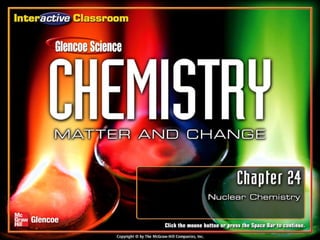
Cmc chapter 24
- 2. Chapter Menu Nuclear Chemistry Section 24.1 Nuclear Radiation Section 24.2 Radioactive Decay Section 24.3 Nuclear Reactions Section 24.4 Applications and Effects of Nuclear Reactions Exit Click a hyperlink or folder tab to view the corresponding slides.
- 4. Section 24-1 Section 24.1 Nuclear Radiation (cont.) radioisotope X ray penetrating power Under certain conditions, some nuclei can emit alpha, beta, or gamma radiation.
- 6. Section 24-1 The Discovery of Radiation (cont.)
- 8. Section 24-1 Types of Radiation (cont.)
- 17. End of Section 24-1
- 19. Section 24-2 Section 24.2 Radioactive Decay (cont.) transmutation nucleon strong nuclear force band of stability positron emission Unstable nuclei can break apart spontaneously, changing the identity of atoms. positron electron capture radioactive decay series half-life radiochemical dating
- 27. Section 24-2 Types of Radioactive Decay (cont.)
- 30. Section 24-2 Types of Radioactive Decay (cont.)
- 31. Section 24-2 Types of Radioactive Decay (cont.)
- 35. Section 24-2 Radioactive Decay Rates (cont.)
- 36. Section 24-2 Radioactive Decay Rates (cont.)
- 40. End of Section 24-2
- 42. Section 24-3 Section 24.3 Nuclear Reactions (cont.) induced transmutation transuranium element mass defect nuclear fission Fission, the splitting of nuclei, and fusion, the combining of nuclei, release tremendous amounts of energy. critical mass breeder reactor nuclear fusion thermonuclear reaction
- 53. Section 24-3 Nuclear Fission (cont.)
- 55. Section 24-3 Nuclear Fission (cont.)
- 58. Section 24-3 Nuclear Reactors (cont.)
- 64. End of Section 24-3
- 66. Section 24-4 Section 24.4 Applications and Effects of Nuclear Reactions (cont.) ionizing radiation radiotracer Nuclear reactions have many useful applications, but they also have harmful biological effects.
- 74. Section 24-4 Biological Effects of Radiation (cont.)
- 78. End of Section 24-4
- 79. Resources Menu Chemistry Online Study Guide Chapter Assessment Standardized Test Practice Image Bank Concepts in Motion
- 94. IB Menu Click on an image to enlarge.
- 95. IB 1
- 96. IB 2
- 97. IB 3
- 98. IB 4
- 99. IB 5
- 100. IB 6
- 101. IB 7
- 102. IB 8
- 103. IB 9
- 104. IB 10
- 105. IB 11
- 106. IB 12
- 107. IB 13
- 108. IB 14
- 109. IB 15
- 110. IB 16
- 111. IB 17
- 112. IB 18
- 113. IB 19
- 114. IB 20
- 115. IB 21
- 116. IB 22
- 117. IB 23
- 118. CIM Table 24.3 Radioactive Decay Processes Figure 24.16 Chain Reactions Figure 24.17 Critical Mass Figure 24.20 Nuclear Power Plants
- 119. Help Click any of the background top tabs to display the respective folder. Within the Chapter Outline, clicking a section tab on the right side of the screen will bring you to the first slide in each respective section. Simple navigation buttons will allow you to progress to the next slide or the previous slide. The “Return” button will allow you to return to the slide that you were viewing when you clicked either the Resources or Help tab. The Chapter Resources Menu will allow you to access chapter specific resources from the Chapter Menu or any Chapter Outline slide. From within any feature, click the Resources tab to return to this slide. To exit the presentation, click the Exit button on the Chapter Menu slide or hit Escape [Esc] on your keyboards while viewing any Chapter Outline slide.
- 120. End of Custom Shows This slide is intentionally blank.